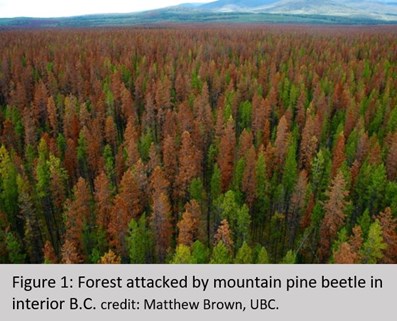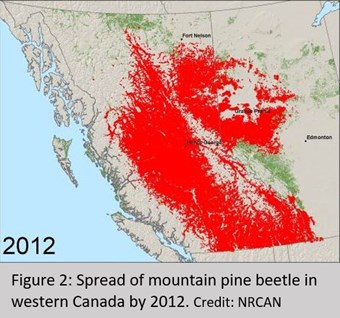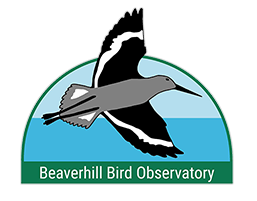Climate Change Connection to Mountain Pine Beetle
Saturday, August 10, 2019Overview
In the previous blog we learnt that forests cover nearly 30% of the land surface and absorb nearly 1/3 of the carbon released due to the fossil fuels burning. A big portion of the Canadian boreal forest, however, is no longer a net carbon sink. 65% of our boreal forest, which is referred to as managed forest, i.e., directly under human influence, is now considered a carbon source. It released 78 megatons of CO2 in 2016, thereby, escalating the climate change crisis. The mountain pine beetle is also contributing to this problem.
 The mountain pine beetle is a small wood-boring species of insect native to western North America. It attacks a wide range of pine species found in western North America such as Lodgepole, Ponderosa, Jack, Whitebark and Limber pines. The beetles attack the trees in large numbers to overcome tree’s defense and lay their eggs inside the bark by tunneling under it. When the eggs hatch, the larvae feed further into the tree, thereby, starving the tree of nutrition, resulting in the tree’s death. However, Lodgepole pine, which co-evolved with the mountain pine beetle, has the natural ability to defend itself against mountain pine beetle attacks. Also, when mountain pine beetle populations are small, they prefer to attack and kill old, and stressed (80+ years) pine forest, thereby, speeding up the development of younger trees. The mountain pine beetles, however, have a negative impact on the forests when their population starts to get bigger. Eventually their population can get so big that they can decimate big patches of the forest.
The mountain pine beetle is a small wood-boring species of insect native to western North America. It attacks a wide range of pine species found in western North America such as Lodgepole, Ponderosa, Jack, Whitebark and Limber pines. The beetles attack the trees in large numbers to overcome tree’s defense and lay their eggs inside the bark by tunneling under it. When the eggs hatch, the larvae feed further into the tree, thereby, starving the tree of nutrition, resulting in the tree’s death. However, Lodgepole pine, which co-evolved with the mountain pine beetle, has the natural ability to defend itself against mountain pine beetle attacks. Also, when mountain pine beetle populations are small, they prefer to attack and kill old, and stressed (80+ years) pine forest, thereby, speeding up the development of younger trees. The mountain pine beetles, however, have a negative impact on the forests when their population starts to get bigger. Eventually their population can get so big that they can decimate big patches of the forest.

History of Mountain Pine Beetle in British Columbia and Alberta
In the earlier part of 20th century, western Canada witnessed small outbreaks of the mountain pine beetle. These outbreaks, while damaging, were followed by a slow period during which the beetle population declined, and the forests had the opportunity to recover. In contrast, the outbreaks of late 1990s and early 2000s continued for a much longer period and decimated big portions of the Lodgepole pine forests.
In 1999, the area impacted by the mountain pine beetle in British Columbia was about 164,000 hectares, which had increased to about 16.3 million hectares by 2009. By 2012 in Alberta, some 1.27 million hectares of forest was impacted by the mountain pine beetle. Figure 2 shows the spread of mountain pine beetle in western Canada by 2012.
Why are the Mountain Pine Beetle on the March?
There are several reasons for the mountain pine beetle outbreaks and their rapid spread. The beetle can travel long distance facilitated by the strong winds. In 2006, strong winds carried the beetle approximately 400 km from central B.C to the Peace River region in Alberta. Another major reason for the vast spread mountain pine beetle is climate change. Extreme cold temperatures can keep the mountain pine beetle population in check. During the winter of 2018-2019, for example,

Alberta’s mountain pine beetle larvae, were estimated to be reduced by ~90% due to the cold February temperatures. However, scientists are concerned that due to the climate change, Canadian winters are getting warmer while the summers are getting hotter, which is contributing to mountain pine beetle outbreaks. Scientists are predicting that the mountain pine beetles will continue to expand their range into the previously unaffected areas, such as high elevations, northern latitudes and eastern longitudes, due to the continuous global warming. Previously these areas were safeguarded from the mountain pine beetle by cold weather. This should especially be a concern for Canadians because as we learned in previous blogs, Canada is warming up at a much faster rate than rest of the world.
Further, fire play an important role in the forest ecology and controlling spread of mountain pine beetle. For example, in the Lodgepole pine forest, fire kills older mature trees, thereby, aiding in forest renewal. Lodgepole pine also depends on fire to release its seeds from the tight cones. Fire suppression, however, has allowed a large portion of the pine forests to become tall and dense, which makes them more susceptible to the mountain pine beetle. About 60% of Alberta’s forests is within the age of 80-120 years making it vulnerable to mountain pine beetle outbreaks.
What can we do?
While scientists and governments are doing their bit to control the mountain pine beetle outbreaks by performing prescribed burns and research, there are many ways that the citizens can help in this issue. Transporting firewood over long distances can spread mountain pine beetles if the wood happens to be infested. Therefore, the government advises the citizens should not move firewood over long distances, and instead buy firewood locally. You can also learn to identify the mountain pine beetle and the symptoms associated with it to keep your pine trees safe. In case you have an infected pine tree, the following resource provide instructions on how to prevent further spread: https://www.alberta.ca/mountain-pine-beetle-prevent-further-spread.aspx
Lastly, since climate change is a big contributor to this problem, we can take steps to reduce our carbon footprint, thereby, reducing the impacts of climate change and helping solve the mountain pine beetle problem. There are many areas, such as food, commuting, and waste, that one can focus on to decrease their carbon footprint. The following link will let you calculate your carbon footprint and you can explore solutions to reduce your footprints; https://www.footprintcalculator.org. Our previous blogs on how to reduce your carbon footprint can be found here: http://beaverhillbirds.com/publications/papers-reports-manuals/
Picture Credit
Matthew Brown, UBC. accessed on January 2nd 2020, retrieved from https://www.flickr.com/photos/140969380@N07/28371273132
NRCAN, accessed on January 2nd 2020, retrieved from https://www.nrcan.gc.ca/forests/fireinsects-disturbances/top-insects/13397
Environment and Climate Change Canada, accessed on January 2nd 2020, retrieved from https://www.canada.ca/en/environment-climate-change/services/climate-change/canadiancentre-climate-services/basics/trends-projections/changes-temperature.html
Additional Readings
http://publications.gc.ca/collections/collection_2011/rncan-nrcan/Fo143-3-2009-30-eng.pdf
http://www.cfs.nrcan.gc.ca/pubwarehouse/pdfs/25048.pdf
https://web.archive.org/web/20100811062345/http://mpb.cfs.nrcan.gc.ca/biology/index_e.ht ml
https://globalnews.ca/news/4952823/mountain-pine-beetle-cold-alberta/
https://www.fs.usda.gov/Internet/FSE_DOCUMENTS/stelprdb5299324.pdf
https://esrd.maps.arcgis.com/apps/Cascade/index.html?appid=b81dbef8d02344e6bb7340876 69626db
https://www.nrs.fs.fed.us/pubs/gtr/gtr-nrs-p-75papers/01carroll-p-75.pdf
http://www.forest-insects.umn.edu/sites/forestinsects.umn.edu/files/12sambarajuecography35.pdf
https://www.nrcan.gc.ca/forests/fire-insects-disturbances/top-insects/13397
http://www.invadingspecies.com/mountain-pine-beetle/
https://abinvasives.ca/resources/programs/buy-it-where-you-burn-it/
Blog Posts
- What is Climate Change
- Drought: What Can We Do?
- Migration and Climate Change; a Complicated Relationship (Part 1)
- Migration and Climate Change; a Complicated Relationship (Part 2)
- Climate Change and Birds’ Resources
- Ladder to Extinction
- Arctic Warming and Ecosystem Impacts
- Climate Change Connection to Mountain Pine Beetle
- Tackling Climate Change Denialism
- Impact of Climate Change on Bluebirds
- An Introduction to Climate Change
- Great Decline of Aerial Insectivores
- Role of Oceans in Fighting Climate Change
- Role Of Forests In Fighting Climate Change
- Impact of Climate Change on Shorebirds
- Impact of Hurricanes and Climate Change on Birds
- An Introduction to Climate Change.
- Impact of Forest Fires, and Climate Change on the Nature
- Impacts of Climate Change on Owls
- Impacts of Climate Change on Birds of Prey
- Whitebark Pine and Clark's Nutcracker
- COVID 19 & The Environment
- Impact of Global Warming on Bird Anatomy and Colour Polymorphism
- Climate Change & West Nile Virus
- All Posts

